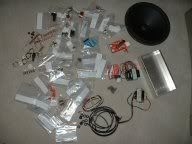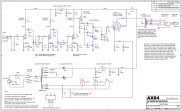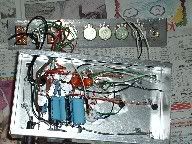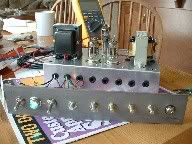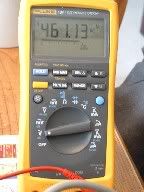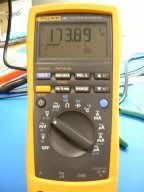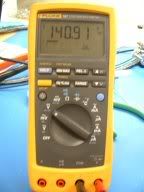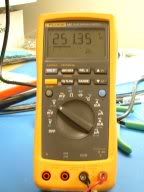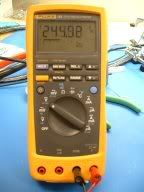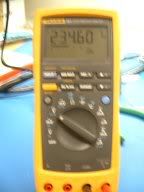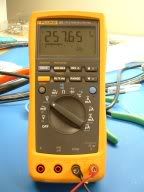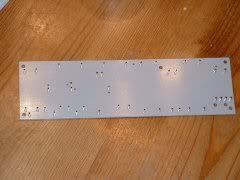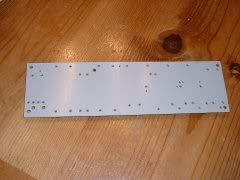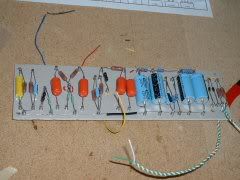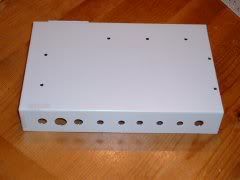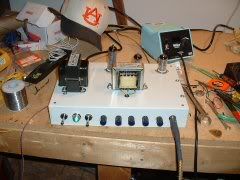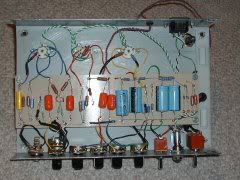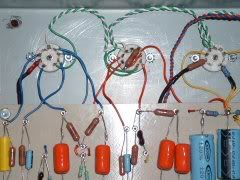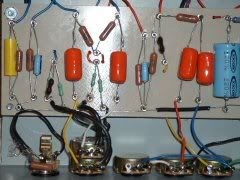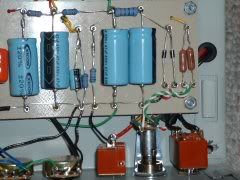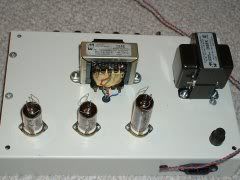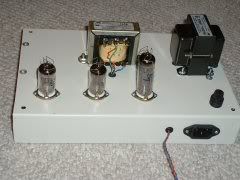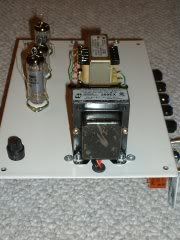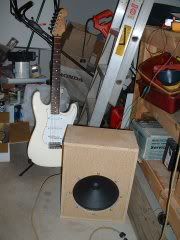The main thing I wanted to accomplish
at first was to get the power supply connected and tested out. I
did my first power-up without the tubes installed to see if my power
indicator light would come on, and it did (without smoke and bad
popping noises that let you know that you are probably finished with a
project such as this). I double-checked the connections to the
tube sockets and checked the filament voltages before installing the
tubes. I wanted to see that warm orange glow from the tube
filaments, so I popped them all in their sockets. The filament in
the power amp tube began to glow (see the out of focus picture) but the
pre-amp tubes did not have the same visible glow, but they did get
warm. I don't know if I should be able to see the filament in
those tubes, but I was satisfied that they did get warm at the
top. At the time I took these pictures I did not have any of the
signal lines connected to the tube sockets.
The power transformer has two outputs
on it. One is rated at 6.3V which powers the indicator lamp and
the filaments only. The other is a 190V output, but what is shown
on the meter below is the AC measurement between primary taps.
This is about the no-load AC range I expect. The no-load DC
measurement at the power supply filter output measures about
213V. So far it looks good. I hope to finish the chassis
wiring this coming weekend to pump some sound through it for the first
time.
[April 29, 2004]
During the final stages of wiring, I realized that the output
transformer (OT) designations on the High-Octane schematic are for a
different transformer than what is in the attached
bill-of-material. The schematic itself does not make this clear
as it mentions a Hammond 125E in a note, but does not designate what
the OT on the schematic really is. Apparantly what it refers to
is the recommended OT for the P1 design (Aikens/Delft OT-5SE is
designated on the P1 schematic), but the one in the High-Octane
bill-of-material is an alternate OT, the Hammond 125E. This is
the OT that I am using. The schematic shows the input at pins
1&2 and the output on pins 3-6. The 125E has pins 1-6
markings on the output, but on the input side there are 3 pins that are
unmarked. I looked over the information at the Hammond web site
and searched the ax84.com forum postings for clues about how it should
really be connected.
Hammond
125E info
Hammond 125
series impedance chart
The outer two pins on the input side are to be used in place of OT
1&2 on the schematic. The center pin is to be left
open. I am not using an impedance selector switch since I am not
making this as a head unit. It will be connected directly to an 8
Ohm speaker; therefore, according to the impedance selection chart, I
use pins 2&6 on the output side for a 4K Ohm input. After the
fact, I realized that the P1 construction guide addresses this in
section 2.5. I should have paid closer attention to this part of
the document.
I finished the wiring over a week ago and after a final checkout, I
plugged it in and turned it on and it worked! I plugged in my
guitar and heard the first sounds out of it. There were two
problems with it: it had a very noticeable 60Hz buzz and when the
gain is turned up high enough, it squealed very loud. At lower
gain levels, the amplified sound was sharp and clear (except for the
induced buzz). I found an old chopstick laying around the house
and began poking on the wires inside to see if moving any of them had
any effect on either of the problems. I soon found a wire that
was not soldered in very well. When I corrected that, the 60Hz
buzz was reduced significantly, to more of a hum, but still very
noticeable; I could still hear it while playing.
I have spent some time over the last week trying to eliminate the
problems. I believe that I have the 60Hz hum corrected, but I
have not yet been able to eliminate the squeal at high gain.
After reading over the P1 construction guide again, I realized that the
two problems that I have are the most common with this amp
design. I pored over the forum postings on the ax84.com web site
looking for clues.
My first thought was that the fields generated by the transformers
could be inducing problems in each other or in the tubes, as they are
all in close proximity on the small chassis that I used. I
wrapped aluminum foil around the tubes as a shield to see if that would
have any effect. It did nothing, but I had to try as it was such
a simple thing to do before I got into anything more involved. I
was suspect of the filament wires thinking that they may be too close
to something in the critical path. I let the tubes warm up for a
while and then I disconnected the filament wiring from the power
transformer for a few seconds. This had no effect. I
decided that the filament wiring is good.
The next thing I did was to replace the input line with shielded cable,
grounding the shield at one end. This did help reduce the 60Hz
hum, but not enough. I then moved the rectifier diodes further
away from the first stage tube, V1. I have since realized that a
fundamental layout design goal is to keep the power supply section away
from the preamp section. Moving the diodes reduced the hum enough
to where it is no longer a problem. It is still present, but at
such a low level that it is not worth any more effort at this time.
I have not been able to move enough wires around to eliminate the
squeal, although I do believe that it is isolated to the preamp
section, possibly V1. I had to know if either transformer could
be inducing the feedback (more likely the OT), so I removed them both
from the chassis to the bench, and reconnected the wiring with added
length to be able to displace them at least 10 or 12 inches from
anything else. I also tried to position all leads to the
transformers away from any other components. This did nothing to
reduce the squeal or to
further reduce the hum. Here's what it looks like today:

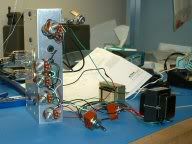
Short of a new layout, I am still
trying to modify what can be reasonably done to resolve this
problem. I put shielded wires on the GAIN-1 potentiometer; still
no change. Whenever I move the signal in wire at V1-2 (connected
through R10) it changes the pitch of the squeal. Moving C5 &
R6 have this affect also; they are positioned very close to R10 at the
V1A grid. These components can only be moved around so much and I
cannot get them into a position to completely eliminate the
feedback. My theory at this point is that the output of the
PREAMP STAGE 2 is too close to the input and this is the source of the
feedback. I don't know if I can expect the preamp signal to
create enough of a field to cause this feedback, but I will next try to
relocate C5 & R6 to see what I get.
I did a spot check on some of the
voltages at various points that were accessible to compare with the
SPICE circuit simulation values noted on the schematic:
V3-9 (236V)
C1 (227V)
C14
(250V)
[May 31, 2004]
I finally gave up on trying to debug
the amp. I could not move the wires and other stuff around enough
to make any difference towards eliminating the feedback squeal.
Plus I was in constant fear that having so many things loosened up to
move around I would eventually let two exposed parts touch that
shouldn't and then I'd be sinking more money into replacement parts
that I had destroyed. Also, I did get shocked a couple of times
in the process and I didn't want any more of that. Finally, the
60Hz AC hum had come back and I could not eliminate (or minimize) it
again at this point. I decided it
was time for plan B.....a totally new layout design. I scrapped
the chassis and wiring diagram that I had put so much time into.
I decided that the next one would be laid out on a turret board and
everything would be mounted to a properly sized chassis.
This time I decided to model my layout after one that was known to
work. I took the layout from the
silvatone
site listed below in the links and for the most part did a mirror-image
of the layout because I still want to make mine a combo unit and mount
the head in the chassis upside down. Here's my layout:

New parts had to be ordered and I cannibalized the old amp to move
all components to the new one. I bought a 12"x24"x1/8" sheet of
Garolite (G-10/FR4) from
McMaster-Carr to use for the turret board. I
also bought 50 turrets and a turret staking tool from
Hoffman Amplifiers.
This turned out to be a real nice way to mount components. I have
enough of the Garolite left over to build 5 or 6 more amps (this should
be enought for my lifetime).
